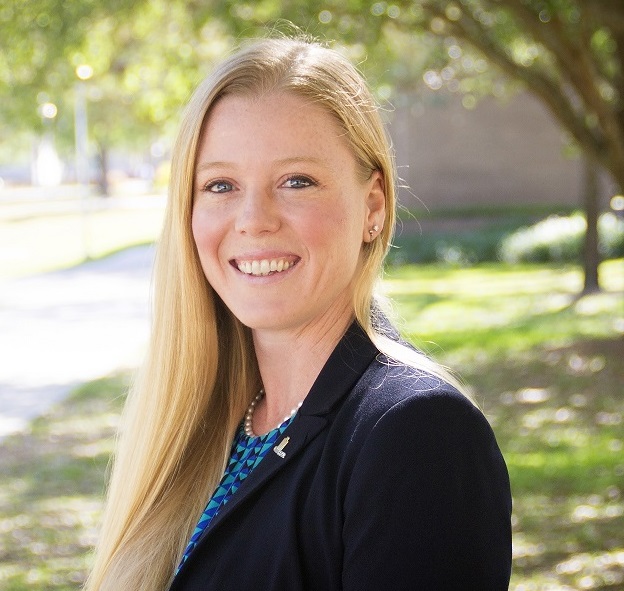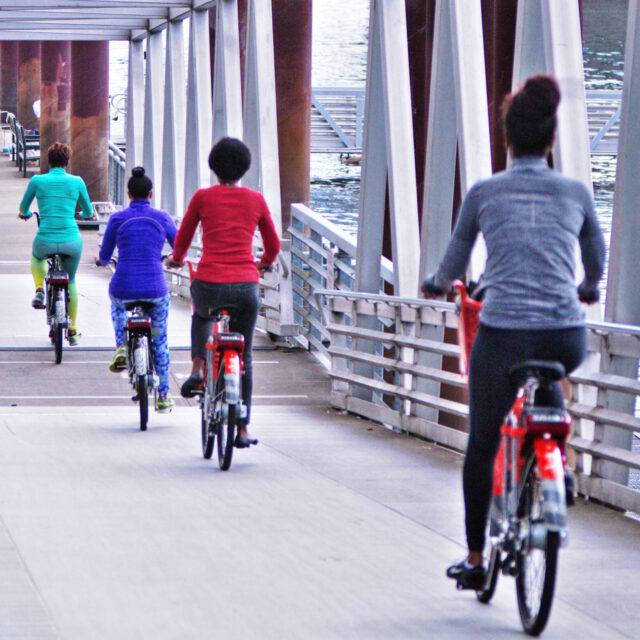Attracting and Retaining Diverse Candidates
by Kiran Herbert, Communications Manager
April 7, 2021
We spoke with Jodi Godfrey of the Center for Urban Transportation Research on ways to make employment at any shared micromobility system better.

Photo courtesy of Metro Bike Share, the bike share system for Los Angeles.
As shared micromobility systems across the country gear up for the weather-induced busy season, hiring is top of mind. And for organizations looking to attract diverse ridership and create public systems that work for everyone, it’s important to look inwards. Whether we’re talking about ambassadors, full-time office employees, or part-time field staff, ensuring your internal culture reflects the diversity of your larger community is a crucial first step to getting external results.
Jodi Godfrey, MSCE, a research associate at the Center for Urban Transportation Research at the University of South Florida (USF), along with the center’s former Director Robert L. Bertini, PhD, has focused specifically on the issue of bringing more women into the field of transportation, whether in engineering, planning, operations, maintenance or research. The pair’s report, “Attracting and Retaining Women in the Transportation Industry,” published in February 2019, summarizes previously conducted studies and identifies additional research needed to attract, promote and retain female employees.

Jodi Godfrey, MSCE
“I found through our research that a lot of the qualities that will attract women to an organization really will attract any good employee,” said Godfrey. “Since this study, I’ve broadened the scope of my work to focus on how to recruit and retain diverse candidates.”
Godfrey acknowledges that the tone of many of her 12 recommendations, outlined below, are heavily influenced by her own personal perspective as a woman in the transportation industry. She also advises that much of the advice—especially the first three recommendations—is holistic, meaning that it won’t produce immediate results but will lead to better outcomes over time. Said Godfrey, “In that way, we encourage future generations of more diverse candidates to be attracted to our industry.”
Recommendations for Improving the Transportation Industry:
1. Connect with young people to promote the industry as a desirable career option.
Mentor, and provide opportunities for others in the industry to mentor as well. The benefits of sharing success stories and providing advice, guidance and prompt answers to mentees cannot be overstated.
“Anything we can do to really share successes is important,” said Godfrey. “That could be as simple as a ‘Great American Teach-In,’ where you encourage kids of all ages to think of a career in transportation as an opportunity they can grow into once they graduate.”
2. Encourage minority employees to participate in professional organizations, especially leadership participation and networking event attendance.
Participation in extracurricular activities can help increase minority visibility within the industry. Seeing someone that looks more diverse makes diverse candidates and employees more confident that they can likewise serve as a leader and advance.
“The Institute of Transportation Engineers propelled me into the transportation industry through scholarships, which led me to attend meetings where I saw leaders that were women,” said Godfrey. “Not only should companies encourage participation in professional organizations, but you should encourage diverse candidates in your organizations to run for leadership positions.”
3. Support minority-focused scholarships, internships, awards and other educational and career opportunities
Increase the recruiting talent pool so that minorities not typically afforded opportunities are. That may require changes in educational tools or traditional information delivery methods in order to ensure that there is a focus on the skills that are needed in the industry. Specifically soft skills, such as public speaking, can be incorporated into curricula without jeopardizing accreditation requirements.
“I came from a background where no one in my family had ever gone to college and no one could afford to send me to college,” said Godfrey. “Scholarships are what gave me the opportunity that made higher education possible.”
4. Intentionally promote desired perceptions.
Deliberately advertise your organization’s support of diversity, equity and inclusion through as many outreach opportunities as possible, including professional organizations and associations, meetings, social media, newsletters and magazine articles.
“If you don’t promote the perception you want, others will come up with their own perceptions of you,” said Godfrey. “We really have to be deliberate in the ways we promote our organizations. That means making sure the people on your social media don’t all look the same and striving for inclusivity in your advertisements.”
5. Promote the community aspect of transportation industry careers.
Many engineers, planners, policymakers, researchers and scientists work in transportation to better the larger community.
“Women especially focus on community goals—they want to be able to help somebody or know they’re bettering their community in some way,” said Godfrey, noting that in general men focus more on agentic goals, like building personal prestige or power. “If we can promote our industry as something that helps the community, we’ll be better at attracting people that are interested in communal goal congruity.”
6. Create a balanced panel for all final decisions pertaining to hiring.
Presenting a gender-balanced hiring panel is one way to show immediate dedication to diversity while reducing bias. Additionally, some companies set quotas for final candidates, agreeing not to move forward with interviews unless the final pool meets a predetermined diversity quota.
“Making sure your internal structure and processes are fair and consistent are going to help companies attract and retain good talent,” said Godfrey. “In mock interviews, I tell my students that it’s not just about companies looking to see if they want to hire you, but also about you exploring whether or not a company is somewhere you want to invest your time. If they can’t come up with anyone other than a panel of white males to interview you, then it’s possible that someone who’s not a white male will ever be able to advance to the level of being on a hiring panel.”
7. Develop and adhere to a defined succession plan to ensure there is no bias in promotion decisions.
With clear promotion guidance that is inclusive of specific requirements for advancement, there is no room for unintentional bias in the promotion process.
“This helps get you out of that “good ol’ boy” loop, where only someone who knows someone is able to move up in an organization,” said Godfrey, noting that not seeing a path to advancement is a common reason provided by women who left the STEM industry.
8. Ensure policies allow employees to take earned time off, without fear of retribution or loss of work availability upon return.
Policies that are family-friendly and allow for time off after childbirth and other dependent care considerate policies will all contribute to retention rates of qualified talent.
“We really have to be cognizant as organizations that there is something in place so that we’re not pushing people out or penalizing them when they need to take or want to take time off,” said Godfrey.
9. Develop and promote a toolbox of applicable guidance.
Learn from other organization’s mistakes and use that experience to help inform your own decision-making. Invest in best practices syntheses that collect and compare transportation organization’s policies and implementation successes.
“There’s no need to recreate the wheel,” says Godfrey. “If you’re looking for a specific policy and no one in bike share has it, maybe someone in transit does.”
10. Conduct or participate in recurring surveys to understand the effectiveness of the cultural diversity efforts in place.
Sharing practices that were ineffective are just as important as sharing practices that were effective.
“For us to continuously improve, we have to be able to measure the state that we’re in,” says Godfrey. “Recurring surveys help us understand how comfortable employees feel; if they’re able to express what they’d like to express or if they feel stifled; if minority voices are amplified or swept under the rug. Feedback allows us to problem solve and leads to the best possible solutions.”
11. Change must occur at every level of an organization to be effective.
Research indicates that DEI initiatives are exponentially more effective when they are championed by senior leadership. To ensure effective cultural improvement, all employees must then also buy into the vision.
“It is important that the diversity policies and other actions are not just enacted from the supervisory level with no real buy-in from the C Suite and the front line employees,” says Godfrey. “In order for real improvement to persist, it must be supported from all levels of the organization.”
12. Don’t discredit those, especially women, with lapses in their employment history.
History shows that if one person in the family has to stop working, it’s typically the woman getting paid less (women currently make 82 cents to the dollar compared to males, and the number is significantly less for Black, Indigenous and Hispanic women).
“We can’t ignore the elephant in the room—the pandemic—which has led many to leave the workforce, whether voluntarily or involuntarily,” says Godfrey. “We also need to be cognizant that we’re not undervaluing our female counterparts as they come back and contributing to future wage gaps.”
Additional tips:
👉 When writing job descriptions, use language that speaks to the skills people need to have rather than the experience you think leads to those skills. Consider using a Competencies Checklist to screen for important skills and traits.
👉 Do away with unnecessary education or physical requirements that aren’t pertinent for the job or explicitly say that you’ll consider alternative ways that an applicant may have gained the required qualifications outside of traditional pathways. Likewise, don’t require applicants to lift 50 pounds when really 15 pounds might suffice for the position at hand.
👉 When prepping to post a job listing, put your advert through the Gender Decoder first. Inspired by a research paper written by Danielle Gaucher, Justin Friesen, and Aaron C. Kay back in 2011, called Evidence That Gendered Wording in Job Advertisements Exists and Sustains Gender Inequality, this tool will check to see if your copy is masculine-coded, which can discourage women from applying. If your copy of overtly feminine-coded, that’s ideal—research shows men will still apply.
👉 Be inclusive with where you’re soliciting candidates—don’t just rely on online job boards. Rather, consider tabling at ethnic grocery stores, reaching out to community organizations to help spread the word about your opening, posting a flyer at the library, or recruiting directly from Historically Black Colleges.
Access a summary of the report’s study methods, findings and policy recommendations here. Access the full study here. Do you have hiring and retention tips to share? A case study you want to be told? Email kiran@peopleforbikes.org.
The Better Bike Share Partnership is funded by The JPB Foundation as a collaborative between the City of Philadelphia, the National Association of City Transportation Officials (NACTO) and the PeopleForBikes Foundation to build equitable and replicable bike share systems. Follow us on Facebook, Twitter and Instagram or sign up for our weekly newsletter.



